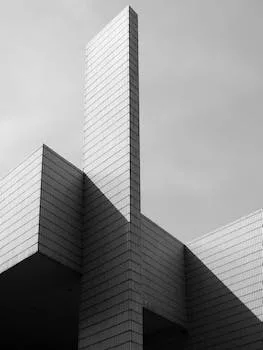Incorporating Sustainable Materials for Longevity in Modern Complex Design
The role of design in creating a low-maintenance modern complex is of paramount importance, as it not only ensures the longevity of the structure but also contributes to the overall sustainability of the built environment. One of the key aspects of designing a low-maintenance complex is the incorporation of sustainable materials that are durable, energy-efficient, and environmentally friendly. These materials not only reduce the need for frequent maintenance and replacement but also contribute to the overall performance and aesthetics of the complex.
The use of sustainable materials in modern complex design is a growing trend, as architects and designers are increasingly recognizing the benefits of incorporating these materials into their projects. Sustainable materials are those that have a low environmental impact, are sourced responsibly, and can be recycled or reused at the end of their life cycle. By using these materials, designers can create buildings that are not only visually appealing but also have a reduced carbon footprint and a longer lifespan.
One of the most popular sustainable materials used in modern complex design is cross-laminated timber (CLT). CLT is a type of engineered wood that is made by gluing together layers of timber at right angles to each other, creating a strong and stable material that can be used for structural elements such as walls, floors, and roofs. CLT has several advantages over traditional building materials such as concrete and steel, including its lower embodied energy, reduced waste during construction, and the ability to sequester carbon throughout its life cycle. Additionally, CLT is lightweight and easy to work with, making it an ideal choice for low-maintenance modern complexes.
Another sustainable material that is gaining popularity in modern complex design is recycled steel. Steel is one of the most commonly used materials in construction, and its production is responsible for a significant amount of greenhouse gas emissions. By using recycled steel, designers can reduce the environmental impact of their projects while still benefiting from the strength and durability that steel provides. Recycled steel can be used for structural elements, cladding, and even interior finishes, making it a versatile and low-maintenance option for modern complexes.
In addition to using sustainable materials for the structure of a modern complex, designers can also incorporate these materials into the building’s exterior envelope. For example, green roofs and living walls are becoming increasingly popular as a way to improve the energy efficiency of a building, reduce stormwater runoff, and create a visually appealing exterior. These systems typically consist of a waterproof membrane, a growing medium, and a variety of plants that are selected for their ability to thrive in the specific climate and conditions of the building site. Green roofs and living walls not only provide insulation and reduce the urban heat island effect but also require minimal maintenance, making them an ideal choice for low-maintenance modern complexes.
In conclusion, the incorporation of sustainable materials in modern complex design is essential for creating a low-maintenance building that is both visually appealing and environmentally responsible. By using materials such as cross-laminated timber, recycled steel, and green roofs, designers can create structures that are durable, energy-efficient, and have a reduced environmental impact. As the demand for sustainable buildings continues to grow, it is likely that we will see even more innovative uses of sustainable materials in the design of modern complexes, ensuring that these structures remain functional and beautiful for generations to come.
Integrating Smart Technologies to Reduce Maintenance Efforts in Contemporary Buildings

The role of design in creating a low-maintenance modern complex cannot be overstated. As urbanization continues to increase, the need for sustainable, efficient, and low-maintenance buildings becomes more pressing. Architects and designers are now tasked with creating structures that not only meet the aesthetic and functional needs of their occupants but also minimize the resources required for their upkeep. One of the most effective ways to achieve this is by integrating smart technologies into the design process, which can significantly reduce maintenance efforts in contemporary buildings.
The integration of smart technologies in building design begins with the selection of materials and construction techniques that are durable, energy-efficient, and require minimal maintenance. For instance, the use of high-performance glazing systems can reduce heat gain and loss, thereby lowering energy consumption and maintenance costs associated with heating, ventilation, and air conditioning (HVAC) systems. Similarly, the incorporation of green roofs and walls can help regulate indoor temperatures, improve air quality, and reduce the need for frequent maintenance.
Another critical aspect of integrating smart technologies in modern complexes is the implementation of building automation systems (BAS). These systems allow for centralized control and monitoring of various building functions, such as lighting, HVAC, and security. By automating these processes, building managers can optimize energy consumption, reduce operational costs, and minimize the need for manual intervention. For example, a BAS can automatically adjust lighting levels based on occupancy and daylight availability, ensuring that energy is not wasted on unnecessary lighting. Additionally, the system can monitor and control HVAC equipment to maintain optimal indoor conditions while minimizing energy consumption.
The use of sensors and the Internet of Things (IoT) devices is another essential component of smart building design. These technologies enable real-time monitoring of various building parameters, such as temperature, humidity, and air quality. By collecting and analyzing this data, building managers can identify potential maintenance issues before they become critical, allowing for proactive maintenance and reducing the likelihood of costly repairs. For instance, sensors can detect water leaks or HVAC system malfunctions, alerting building managers to the problem and enabling them to address it promptly.
Energy management is another crucial aspect of smart building design. By incorporating renewable energy sources, such as solar panels and wind turbines, modern complexes can generate a portion of their energy needs, reducing their reliance on non-renewable resources and lowering maintenance costs associated with traditional energy systems. Additionally, energy storage systems, such as batteries, can be used to store excess energy generated during periods of low demand, further enhancing the building’s energy efficiency and reducing maintenance efforts.
Lastly, the integration of smart technologies in contemporary buildings extends to the design of outdoor spaces. For example, the use of permeable paving materials can help manage stormwater runoff, reducing the need for extensive drainage systems and their associated maintenance. Similarly, the incorporation of smart irrigation systems can optimize water usage in landscaped areas, ensuring that plants receive the appropriate amount of water while minimizing waste and maintenance requirements.
In conclusion, the role of design in creating a low-maintenance modern complex is paramount. By integrating smart technologies into the design process, architects and designers can significantly reduce maintenance efforts in contemporary buildings. This not only results in more sustainable and efficient structures but also contributes to the overall well-being of their occupants and the surrounding environment. As urbanization continues to grow, the importance of incorporating smart technologies in building design will only become more critical, shaping the future of our cities and communities.
Landscape Design Strategies for Low-Maintenance Urban Complexes
The role of design in creating a low-maintenance modern complex cannot be overstated. As urban areas continue to expand and evolve, the need for sustainable, efficient, and low-maintenance spaces becomes increasingly important. Landscape design strategies play a crucial role in achieving these goals, as they can significantly reduce the time, effort, and resources required to maintain urban complexes. By incorporating innovative design elements and techniques, landscape architects can create aesthetically pleasing, functional, and environmentally friendly spaces that require minimal upkeep.
One of the primary objectives of low-maintenance landscape design is to minimize the need for regular maintenance tasks such as mowing, watering, and pruning. This can be achieved by selecting appropriate plant species and materials that are well-suited to the local climate and require minimal care. Native plants, for example, are often more resilient and better adapted to local conditions, making them an ideal choice for low-maintenance landscapes. Additionally, drought-tolerant plants can significantly reduce the need for irrigation, further reducing maintenance requirements.
Another key aspect of low-maintenance landscape design is the strategic use of hardscape elements, such as paving, walls, and seating areas. These features not only add visual interest and functionality to the space but also help to reduce maintenance by minimizing the amount of vegetation that needs to be cared for. For example, incorporating permeable paving materials can help to manage stormwater runoff, reducing the need for additional drainage systems and maintenance. Similarly, using durable, low-maintenance materials for walls and other structures can help to ensure that they remain in good condition with minimal upkeep.
In addition to selecting appropriate plants and materials, the layout and organization of the landscape play a crucial role in creating a low-maintenance urban complex. By carefully considering the placement of plants, hardscape elements, and other features, landscape architects can create spaces that are both visually appealing and easy to maintain. For example, grouping plants with similar water and sunlight requirements can help to streamline maintenance tasks, while also creating a cohesive and harmonious aesthetic. Furthermore, incorporating clear circulation paths and well-defined spaces can help to reduce the potential for damage and wear, making it easier to maintain the overall appearance and functionality of the complex.
Sustainable design principles also play a significant role in creating low-maintenance urban complexes. By incorporating features such as green roofs, rain gardens, and bioswales, landscape architects can help to manage stormwater runoff, reduce the urban heat island effect, and improve air quality, all while minimizing maintenance requirements. These features not only contribute to the overall sustainability of the complex but also provide valuable ecosystem services that benefit both the environment and the people who live and work in the area.
Finally, it is important to consider the long-term maintenance requirements of the landscape when designing a low-maintenance urban complex. This includes selecting plants and materials that are not only low-maintenance in the short term but also have a long lifespan and can withstand the rigors of an urban environment. Additionally, incorporating flexible design elements that can be easily adapted or modified as the needs of the complex change can help to ensure that the landscape remains functional and attractive with minimal intervention.
In conclusion, the role of design in creating a low-maintenance modern complex is multifaceted and involves a careful consideration of various factors, including plant selection, materials, layout, and sustainable design principles. By incorporating these strategies, landscape architects can create urban complexes that are not only visually appealing and functional but also require minimal maintenance, making them more sustainable and efficient in the long run.
Q&A
Question 1: What is the role of design in creating a low-maintenance modern complex?
Answer 1: The role of design in creating a low-maintenance modern complex is to ensure that the architectural, structural, and aesthetic elements are planned and executed in a way that minimizes the need for frequent repairs, replacements, and upkeep. This involves selecting durable materials, incorporating energy-efficient systems, and designing spaces that are easy to clean and maintain.
Question 2: How can design elements contribute to the sustainability of a modern complex?
Answer 2: Design elements can contribute to the sustainability of a modern complex by incorporating features such as green roofs, solar panels, and rainwater harvesting systems. Additionally, using energy-efficient lighting, proper insulation, and passive solar design can help reduce energy consumption. Sustainable materials and waste management systems can also be integrated into the design to minimize the environmental impact of the complex.
Question 3: What are some key considerations for designing a low-maintenance modern complex?
Answer 3: Some key considerations for designing a low-maintenance modern complex include selecting durable and long-lasting materials, designing spaces that are easy to clean and maintain, incorporating energy-efficient systems, and planning for future adaptability. Additionally, considering the local climate and environmental factors, as well as ensuring accessibility and safety for all users, can contribute to a successful low-maintenance design.
Conclusion
In conclusion, the role of design in creating a low-maintenance modern complex is crucial as it directly impacts the efficiency, sustainability, and overall functionality of the complex. By incorporating innovative materials, technologies, and design principles, architects and designers can significantly reduce maintenance requirements, enhance the durability of structures, and promote a more sustainable and cost-effective approach to modern complex development.


